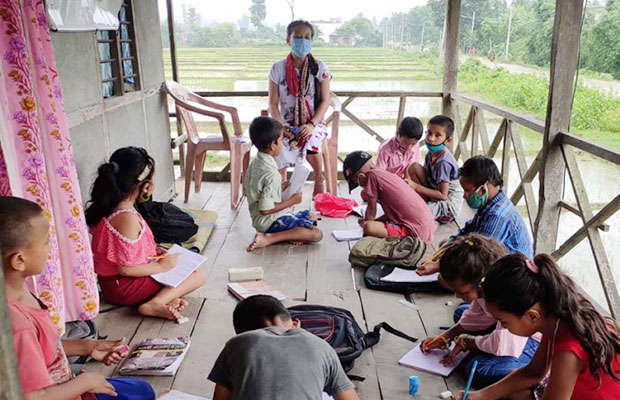
Overcoming Adversity to Educate Nepal’s Youth
What happens when COVID-19 closures and restrictions threaten educational continuity for students in Nepal? Our Salesian missionaries step up with creative solutions—just as they did in 2015, when a catastrophic earthquake destroyed more than 1,300 schools in 75 districts across the country.
In the aftermath of that devastating earthquake—when more than 8,000 people died, nearly 20,000 were injured, and half a million victims were forced from their homes—missionaries in Nepal prioritized getting children back to school, even as they worked tirelessly to provide immediate humanitarian aid and planned for long-term reconstruction. Today, the more than 20 “temporary” learning centers they built are of such high quality that they are still in use and will likely become permanent—and at least another 20 are in the works.
Although the global pandemic has thrown an unanticipated wrench into those plans, and students cannot currently occupy the new classrooms, our missionaries’ commitment to their education remains steadfast.
“Even before the earthquake, Nepal struggled with high rates of poverty,” explains Father Gus Baek, director of Salesian Missions. “That’s why it was so important then to prevent students from falling even further behind—just as it remains important now. The longer children are out of school, the less likely they are to return—which negatively impacts their futures, their families’ futures, and the futures of their communities. Simply put, their education can’t wait.”
Salesian missionaries have been serving in Nepal for 25 years, building schools and offering life-changing programs and services for poverty-stricken youth and families in and around Kathmandu, its surrounding suburbs, and several rural areas around the country. During that time, they have built a reputation of familiarity and trust that, in turn, strengthens their effectiveness in times of crisis and challenge.
Due to social distancing requirements, schools across the country have been closed since the spring—leaving many students who are unable to access online instruction without a viable alternative to education. Drawing upon 2015’s successes, missionaries have stepped up to fill the void by renting 42 open-air rooms that now serve as “community classrooms.”
As a result, school is back in session for approximately 1,500 students who live in and around Bharoul in eastern Nepal. Forty-six teachers from two Salesian schools lead lessons for 10 students at a time in these community classrooms, covering subjects including English, Nepali, math, science and social studies.
“It’s been rewarding to hear how excited students are to resume their studies,” says Fr. Gus. “According to my colleagues in Bharoul, 95 percent of children have been attending lessons in the community classrooms since they first opened on July 16. And their parents are grateful, too.”
Bharoul’s local government has officially approved this new model of learning, which adheres to all pandemic-related regulations, including mask usage, social distancing and frequent hand-washing.
Until formal education returns to “normal” in Nepal, Salesian missionaries will continue to innovate to keep student education on track. In a country where 40 percent of the population is under the age of 18, their commitment to youth will lead to a brighter future.
Our mission offers adaptive and innovative educational opportunities which give hope to impoverished communities. What’s your mission?
Learn more about our work in Nepal.

